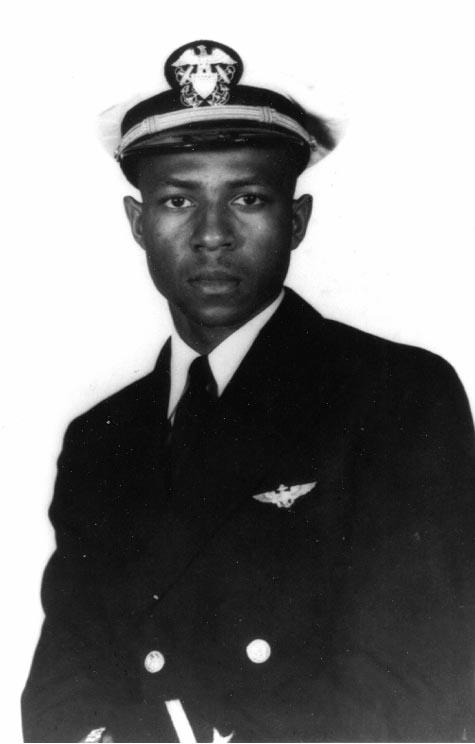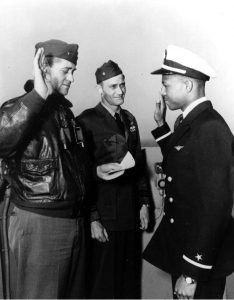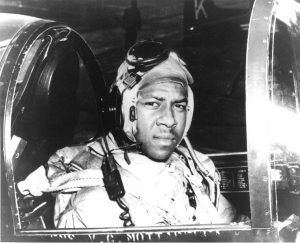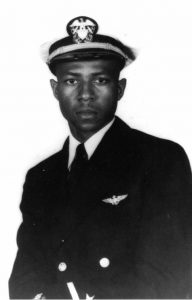
Jesse LeRoy Brown (October 13, 1926 – December 4, 1950) was a United States Navy officer. He was the first African-American aviator in the U.S. Navy, a recipient of the Distinguished Flying Cross, and the first African-American naval officer killed in the Korean War.
Brown was born on October 13, 1926 in Hattiesburg, Mississippi. He was one of six children born to Julia Lindsey Brown, a schoolteacher, and John Brown, a grocery warehouse worker. He had four brothers, Marvin, William, Fletcher, and Lura, as well as an older sister known as Johnny. The family lived in a house without central heating or indoor plumbing so they relied on a fireplace for warmth. As a child, Jesse’s brother William fell into this fireplace and was severely burned.
At the beginning of the Great Depression, John Brown lost his job and relocated the family to Palmer’s Crossing, 10 miles from Hattiesburg, where he worked at a turpentine factory until he was laid off in 1938. John Brown then moved the family to Lux, Mississippi, to be a part of a sharecropper farm. During this time, Jesse Brown shared a bed with his brothers and attended a one-room school 3 miles away. His parents were very strict about school attendance and homework, and Jesse Brown walked to school every day. The Browns also were committed Baptists and Jesse, William, and Julia Brown sang in the church choir. In his spare time, Brown also worked in the fields of the farm harvesting corn and cotton.
 When Brown was six years old, his father took him to an air show. Brown gained an intense interest in flying from this experience, and afterward, was attracted to a dirt airfield near his home, which he visited frequently in spite of being chased away by a local mechanic.
When Brown was six years old, his father took him to an air show. Brown gained an intense interest in flying from this experience, and afterward, was attracted to a dirt airfield near his home, which he visited frequently in spite of being chased away by a local mechanic.
At the age of thirteen, Brown took a job as a paperboy for the Pittsburgh Courier, a black press paper,and developed a desire to pilot while reading in the newspaper about African-American aviators of the time including C. Alfred Anderson, Eugene Jacques Bullard, and Bessie Coleman. He also became an avid reader of Popular Aviation and the Chicago Defender, which he later said heavily influenced his desire to fly naval aircraft. In his childhood he was described as “serious, witty, unassuming, and very intelligent.” In 1937, he wrote a letter to U.S. President Franklin D. Roosevelt in which he complained of the injustice of African-American pilots being kept out of the U.S. Army Air Corps, to which the White House responded with a letter saying that it appreciated the viewpoint.
Because the schools closer to his family were of lower quality, in 1939, Brown lived with his aunt and attended the segregated Eureka High School in Hattiesburg. He was a member of the basketball, football, and track and field teams and he was an excellent student, graduating as the salutatorian in 1944. During this time, Brown met his future wife, Daisy Pearl Nix.
Following graduation, Brown sought to enroll in a college outside of the South. His principal, Nathaniel Burger, advised he attend an all-black college, as his brother Marvin Brown had done, however, he ended up enrolling at Ohio State University as his childhood role model, Jesse Owens, had done. Burger told Brown only seven African Americans had graduated from the school that year, but Brown nonetheless was determined to enroll, feeling he would compete well with white students.
Brown took several side jobs to save money for college, including waiting tables at the Holmes Club, a saloon for white U.S. Army soldiers. In this job, Brown was frequently the target of racist vitriol and abuse, but nonetheless persevered, earning $600 to pay for college. In the autumn of 1944, Brown took a segregated train to Columbus, Ohio, and began school at Ohio State.
Brown moved into an on-campus boarding house at 61 East Eleventh Avenue in the primarily black neighborhood of the University District in Columbus, and majored in architectural engineering. Brown attempted several times to apply to the school’s aviation program, but was denied because of his race. Brown joined the track and field team as well as the wrestling team, but soon dropped both for financial reasons. He took a job as a janitor at a local Lazarus department store and then was hired by the Pennsylvania Railroad to load boxcars from 3:30 pm to midnight each day. In spite of this, he maintained top grades in his classes. Facing difficulties with his academics and the institutional segregation in the city, Brown nevertheless found most of his fellow students were friendly toward him.Brown rarely returned to Mississippi during the school year, but in the summers he worked at a dry cleaner in Hattiesburg to help pay for his classes.
During his second year in college, Brown learned of the V-5 Aviation Cadet Training Program being conducted by the U.S. Navy to commission naval aviation pilots. This program operated at 52 colleges, none of which were predominantly black colleges, so only students such as Brown, who attended integrated colleges, were eligible. In spite of resistance from recruiters, Brown passed the entrance exams. Brown enlisted in the U.S. Naval Reserve on July 8,1946 and was admitted to the aviation program, becoming a Seaman Apprentice in the U.S. Navy and a member of the school’s Naval Reserve Officer Training Corps (NROTC) program. A $50 monthly stipend allowed him to quit his jobs and complete his architectural engineering degree in 1947. At this time, the NROTC was the normal route to a regular Naval commission, but only 14 out of more than 5,600 NROTC students in 1947 were black.
On March 15, 1947, Brown reported to Glenview Naval Air Station in Glenview, Illinois, for Naval Flight Officer training. There, his enlistment ended April 15 and Brown reverted to the rank of midshipman, becoming the only African American in the program. Although he anticipated antagonism, he found the other cadets were generally friendly and welcoming. He found many of the black cooks and janitors hostile to him, however, possibly due to jealousy. Brown got his first flight time aboard a Stearman N2S trainer aircraft.
In spite of the rigors of the initial training, Brown was encouraged by instructors and completed the first phase of training, transferring to Ottumwa Naval Air Station in Ottumwa, Iowa, for the next phase. The Ottumwa training involved intense physical fitness and technical training, which Brown completed. Thereafter, he was moved to Pensacola Naval Air Station in Pensacola, Florida, to train in aircraft flight.
In Pensacola, Brown and Nix married in secret, as naval cadets were not allowed to marry until their training was complete, under threat of immediate dismissal. Nix took a room in Pensacola, and the two visited one another on weekends. In spite of overt racism from at least one instructor and several classmates at this posting, Brown completed the rigorous training in August 1947.
By June 1948, Brown had begun training for carrier-based aircraft, and hoped to fly either the F4U Corsair or F6F Hellcat, both of which were fighters. He trained in carrier takeoffs and landings aboard the light carrier USS Wright, after which he was sent to Jacksonville, Florida, for final flight qualifications. On October 21, 1948, he completed his training and was given his Naval Aviator Badge. This accomplishment was widely publicized, and Brown became known nationally. The Associated Press profiled him and his photograph appeared in Life magazine. Author Theodore Taylor later wrote that through Brown’s efforts to become a pilot, he had broken the “color barrier” which had been longstanding and preventing blacks in naval aviation.
Brown was commissioned as an ensign in the U.S. Navy in April 1949. He was assigned to Quonset Point  Naval Air Station in Quonset, Rhode Island, as a part of the U.S. Atlantic Fleet. Brown reported that incidents of racism and discrimination, which had been harsh late in his training, were substantially relieved once he became an officer. Following his commissioning, Brown was assigned to temporary duty at Norfolk Naval Air Station in Norfolk, Virginia. His daughter, Pamela Elise Brown, was born in December. In January 1950, Brown was assigned to Fighter Squadron 32 aboard USS Leyte. Over the next 18 months, the unit conducted numerous training exercises along the East Coast, many of them taking place at Quonset Point. Brown reported here his superiors treated him fairly and held others to equal standards.
Naval Air Station in Quonset, Rhode Island, as a part of the U.S. Atlantic Fleet. Brown reported that incidents of racism and discrimination, which had been harsh late in his training, were substantially relieved once he became an officer. Following his commissioning, Brown was assigned to temporary duty at Norfolk Naval Air Station in Norfolk, Virginia. His daughter, Pamela Elise Brown, was born in December. In January 1950, Brown was assigned to Fighter Squadron 32 aboard USS Leyte. Over the next 18 months, the unit conducted numerous training exercises along the East Coast, many of them taking place at Quonset Point. Brown reported here his superiors treated him fairly and held others to equal standards.
By the outbreak of the Korean War, he had gained a reputation among the others in the squadron as an experienced pilot and a capable section leader. He was well-liked among other pilots and the black stewards and support staff of the carrier. Brown did not socialize much with the other pilots, however, and was known to spend as much time as possible visiting his wife. He was able to reveal his marriage following his commissioning.
On the night of June 25, 1950, ten divisions of the North Korean People’s Army launched a full-scale invasion of the nation’s neighbor to the south, the Republic of Korea. The force of 89,000 men moved in six columns, catching the Republic of Korea Army by surprise, resulting in a rout. The smaller South Korean army suffered from widespread lack of organization and equipment, and was unprepared for war. The numerically superior North Korean forces destroyed isolated resistance from the 38,000 South Korean soldiers on the front before it began moving steadily south. Most of South Korea’s forces retreated in the face of the invasion. The North Koreans were well on their way to South Korea’s capital of Seoul within hours, forcing the government and its shattered army to retreat farther south.

